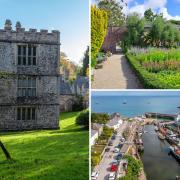2017 marks the opening of a bigger and better Tate St Ives with a new director at its helm. Ewen Macdonald asks Anne Barlow about what we can expect from the new-look gallery under her leadership

Tate St Ives reopens (in part) at the end of this month with a bang – featuring two exhibitions considering the ocean and the landscape and spanning different mediums, a century of ceramics and featuring specially commissioned work.
That Continuous Thing explores 100 years of the ceramics studio, while artist Jessica Warboys solo show features film, performance and the specially commissioned Sea Paintings, to investigate myth, symbolism and the landscape. The exhibitions open 31 March in the existing gallery and is the first to be overseen by new Tate St Ives director Anne Barlow.
We’ll have to wait a little longer for the full effect. The new space at Tate St Ives is due to open in the autumn and is set to include a permanent display of work from the Tate collection by artists associated with St Ives, as well as the seasonal exhibitions celebrating the best in modern and contemporary, British and international art which the Tate brand has been so successful at.
Tate St Ives will soon have an unprecedented opportunity to show a selection of artwork from Tate’s collection all year round in the original, refurbished galleries, alongside a vibrant contemporary art programme,’ says Anne Barlow about the new extension. This will primarily be presented in the new extension, but having two adjacent spaces will allow us to present exhibitions and displays that occasionally combine historic and contemporary works.’
Plans are also underway to bring fresh perspectives to Tate’s considerable collection of artworks, particularly the St Ives modernists who will find a permanent home at the new gallery, through artistic interventions, new commissions, performances, and research-based projects that will keep Tate St Ives at the forefront of current art practices which often reflect today’s society.
Art is often at the forefront in terms of addressing critical social, political and cultural issues so it has the ability to affirm, test out, and sometimes challenge the views and beliefs of those encountering it,’ says Anne. It therefore has a vital role to play in society overall, but those moments when one individual is profoundly affected by an artwork, whether for its critical content and/or aesthetic power, should also not be overlooked.
It is perhaps important to remember that artists such as Hepworth, Nicholson and Gabo first came to Cornwall during the Second World War which was characterised by many of those issues, so each era brings with it its own social and political challenges.’
When fully opened the new gallery promises to present high-profile exhibitions and make space for experimenting with artistic practices and also the ways in which the museum engages with its audiences.
Tate St Ives, especially after the renovation and expansion, will be a key destination and educational resource in terms of presenting collection displays that will change over time, an expanded exhibitions programme, film screenings and events, and learning programmes that will be designed for a wider visiting public as well as for specific local audiences.
We are also interested in deepening our existing relationships with other arts and educational institutions in the region, and continuing to strengthen Cornwall’s artistic importance on a local and international scale in terms of both its legacy and its future.’
Tate St Ives created projects that engage the immediate community in St Ives, as well as the broader community of Cornwall. The Town Project and Look Groups are amazing examples of what can be achieved by learning and exploring together; for communities, Tate St Ives and local cultural partners.
Jessica warboys
Jessica Warboys is a British artist who works across a range of media, including sculpture, painting, film, stained glass, performance and the large-format canvases she titles Sea Paintings 2009 – ongoing. For her first solo show in a national gallery in the UK, Warboys showcases two specially commissioned works, highlighting her interest in personal and collective memories related to art history, mythology and landscape.
An alumni of Falmouth College of Art and Slade School of Fine Art, Warboy’s commissioned Sea Painting (2015) was made on the Zennor coast, near St Ives. Warboys’ ongoing series first arose from her desire to use the beach as a studio and to work on a large scale with an element of performance or ritual. When creating the paintings, Warboys works on the shore, throwing pigments onto huge swathes of sea-drenched raw canvas and allowing the waves, wind and sand to shift, scatter and drag the pigment.
These paintings will also provide a backdrop to several new sculptures and an installation of objects that reoccur across Warboys’ work in film, performance and exhibitions.
A suite of films made in the UK will be shown, highlighting her enduring interest in landscape, pagan history and often overlooked historical figures: Pageant Roll 2012, made in the ancient landscape of the Cornish moors; Boudica 2014, which explores both the historic character and her namesake, the Boudicca Way in Norfolk; and a new film, Hill of Dreams 2016, which has been specially commissioned by Tate St Ives, Casa Masaccio San Giovanni Valdarno, Italy and Kunsthall Stavanger, Norway.
Hill of Dreams draws from Welsh fantasy writer Arthur Machen’s book of the same name, a semi-autobiographical novel written in 1907 that relives his childhood memories of a rural Gwent, where Warboys was born a century later.
Warboys films are deliberately fragmented in the way that memory and history are recalled in moments, rather than continuously. By mixing up historical fact with myths, the viewer is no longer able to tell who the memories belong to, and which bits are arefact, fiction or magic.



























